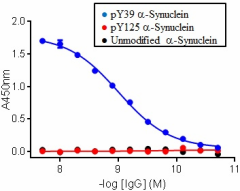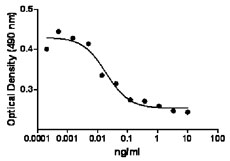- Regulatory Status
- RUO
- Other Names
- Please refer to individual product datasheets.
- Ave. Rating
- Submit a Review
- Product Citations
- publications

-

Direct ELISA of purified anti-α-Synuclein Phospho (Tyr39) antibody (clone A15119B) binding to plate-immobilized recombinant human unmodified and pY39 and pY125 α-synuclein proteins. ELISA was performed by coating wells with 150 ng of each recombinant α-synuclein protein. The wells were then incubated with the primary antibody at 37°C for one hour, followed by incubation with horseradish peroxidase labeled goat anti-mouse secondary antibody. TMB (3, 3', 5, 5' tetramethylbenzidine, Cat. No. 421501) was used as the detection system. -

Western blot of purified anti-α-Synuclein, 80-96 antibody (clone A15115A), and isotype-matched IgG1 control, demonstrating the binding specificity of clone A15115A to endogenous and recombinant human α-synuclein. Lane 1: 50 ng of recombinant human α-synuclein; Lane 2: 50 ng of recombinant human pS87 α-synuclein; Lane 3: 25 µg of normal human brain lysate. The blots were incubated with 1.0 µg/mL of clone A15115A or mouse IgG1, κ at room temperature for two hours, followed by incubation with horseradish peroxidase labeled goat anti-mouse secondary antibody. Enhanced chemiluminescence was used as the detection system. -

IHC staining of α-synuclein deposits with purified anti-α-Synuclein, C-Terminal Truncated antibody (clone A15127A) on formalin-fixed, paraffin-embedded Parkinson's disease brain tissue. Following antigen retrieval using 70% formic acid, the tissue was incubated with the primary antibody at 5 µg/mL overnight at 4°C. BioLegend's Ultra-Streptavidin (USA) HRP kit was used for detection followed by hematoxylin counterstaining, according to the protocol provided. -

Direct ELISA of purified anti-α-Synuclein, C-Terminal Truncated antibody (clone A15127A) binding to plate-immobilized recombinant human full-length (1-140) and C-terminally fragmented (1-122) α-synuclein. ELISA was performed by coating wells with 150 ng of each recombinant α-synuclein protein. The wells were then incubated with the primary antibody at 37°C for one hour, followed by incubation with horseradish peroxidase labeled goat anti-mouse secondary antibody. TMB (3, 3', 5, 5' tetramethylbenzidine, Cat. No. 421501) was used as the detection system. -

IHC staining of purified anti-α-Synuclein Phospho (Ser129) antibody (clone P-syn/81A) on formalin-fixed paraffin-embedded diseased human brain tissue. Following antigen retrieval using 70% formic acid for 20 minutes at room temperature, the tissue was incubated with 1 µg/ml of the primary antibody overnight at 4°C. BioLegend´s Ultra-Streptavidin (USA) HRP kit (Multi-Species, DAB, Cat. No. 929901) was used for detection followed by hematoxylin counterstaining, according to the protocol provided. The image was captured with a 40X objective. -

Western blot of anti-α-Synuclein antibody (clone A15126D) and isotype-matched IgG2b control, binding to endogenous and recombinant human α-synuclein. Lane 1: 50 ng of recombinant human α-synuclein; Lane 2: 50 ng of recombinant C-terminally truncated human α-synuclein (1-122). Lane 3: 20 µg of normal human brain lysate. The blots were incubated with 1 µg/ml of cloneA15126D or mouse IgG22, κ at room temperature for two hours, followed by incubation with horseradish peroxidase labeled goat anti-mouse secondary antibody (clone Poly4053). Enhanced chemiluminescence was used as the detection system.
| Cat # | Size | Price | Quantity Check Availability | Save | ||
|---|---|---|---|---|---|---|
| 899903 | 1 kit | 338€ | ||||
α-Synuclein is expressed principally in the nervous system, but it is also produced in other tissues, including the skin. In the brain, the protein is primarily neuronal, but it is also present in glia. Neuronal α-Synuclein is concentrated in presynaptic nerve terminals, interacts with plasma membrane phospholipids, and is also present in nuclei and mitochondria. At least three isoforms of α-Synuclein are produced through alternative splicing. The most common isoform is a 140 amino acid-long transcript. Other isoforms include, α-Synuclein-126, lacking residues 41-54; and α-Synuclein-112, which lacks residues 103-130. α-Synuclein’s physiological role is poorly understood, but the protein has been implicated in regulating dopamine release and transport, synaptic vesicle clustering, and functioning as a SNARE-complex chaperone. α-Synuclein fibrils are a major component of the intracellular Lewy bodies that are associated with Parkinson's disease, Lewy body dementia, and multiple system atrophy. α-Synuclein is phosphorylated at low levels under normal physiological conditions whereas the majority of the protein is phosphorylated in Lewy bodies at S129. Phosphorylation of α-Synuclein at Tyr39 may modulate clearance of the protein and contribute to Parkinson’s disease. In addition, cleavage of α-Synuclein at amino acid 122 was shown to generate a truncated, aggregation-prone fragment, similar to what has been observed in PD and DLB brains. The α-Synuclein Antibody Sampler Kit provides flexibility for sampling and detection of total, truncated and phosho-specific species of α-Synuclein in human tissue.
Product DetailsKit Contents
- Kit Contents
-
Specificity Format Clone Size Reactivity Isotype Anti-α-Synuclein Phospho (Tyr39) Purified A15119B 25 μg Human Mouse IgG1, κ Anti-α-Synuclein, 80-96 Purified A15115A 25 μg Human Mouse IgG1, κ Anti-α-Synuclein (C-Terminal Truncated x-122) Purified A15127A 25 μg Human Mouse IgG1, κ Anti-α-Synuclein Phospho (Ser129) Purified P-syn/81A 25 μg Human Mouse IgG2a, κ Anti-α-Synuclein, 117-122 Purified A15126D 25 μg Human Mouse IgG2b, κ * For detailed information about each specificity, please refer to the datasheets of the individual products.
Product Details
- Verified Reactivity
- Human
- Host Species
- Mouse
- Formulation
- Please refer to individual product datasheets of the purified formats for details.
- Preparation
- All antibodies in this kit were purified by affinity chromatography.
- Storage & Handling
- Upon receipt, store undiluted at 2-8°C.
- Application
-
IHC-P, WB - Quality tested
- Recommended Usage
-
Each lot of antibodies in this kit is quality control tested by immunohistochemical staining on formalin-fixed paraffin-embedded tissue or Western blotting. For immunohistochemistry, the suggested uses of these reagents are as follows:
Anti-α-Synuclein Phospho (Tyr39): 2.0 - 10.0 µg/ml
Anti-α-Synuclein, 80-96: 2.0 - 10.0 µg/ml
Anti-α-Synuclein (C-Terminal Truncated x-122): 2.0 - 10.0 µg/ml
Anti-α-Synuclein Phospho (Ser129): 1:500 - 1:1000 dilution
For Western blotting, the suggested uses of these reagents are as follows:
Anti-α-Synuclein, 117-122: 0.5 - 2.0 µg/ml
It is recommended that the reagent be titrated for optimal performance for each application. - Application Notes
-
For verified or reported applications for these antibodies, please see individual product datasheets.
- RRID
-
AB_2734653 (BioLegend Cat. No. 899903)
Antigen Details
- Structure
- α-Synuclein's canonical isoform is a 140 amino acid protein with an apparent molecular mass of 14 kD.
- Distribution
-
Tissue distribution: Primarily nervous system, but lower expression in other tissues.
Cellular distribution: Cytoskeleton, cytosol, lysosome, mitochondria, nucleus, plasma membrane, and extracellular. - Biology Area
- Cell Biology, Neurodegeneration, Neuroscience, Protein Misfolding and Aggregation
- Molecular Family
- α-Synuclein, Phospho-Proteins
- Antigen References
-
- Wang W, et al. 2016. PNAS. 113(34):9587.
- Mor DE, et al. 2016. Neurobiol Dis. 88:66. PubMed
- Jucker M & Walker LC. 2013. Nature. 501(7465):45. PubMed
- Bartels T, et al. 2011. Nature. 477(7362): 107. PubMed
- Devine MJ, et al. 2011. Mov Disord. 26:2160. PubMed
- Mahul-Mellier AL, et al. 2014. Hum Mol Genet. 23(11):2858. PubMed
- Waxman EA, Giasson BI. 2008. J. Neuropathol. Exp. Neurol. 67(5):402-16.
- Lim Y, et al. 2011. J. Neurosci. 31:10076. (IF)
- Volpicelli-Daley LA, et al. 2014. Mol. Biol. Cell. 25:4010. (IF) PubMed
- Volpicelli-Daley L, et al. 2014. Nat Protoc. 9:2135-2146. PubMed
- Doppler K, et al. 2016. Brain. 139: e5. PubMed
- Breid S, et al. 2016. J Virol. 90: 9182 - 9193. PubMed
- Lee J, et al. 2017. J Neuropathol Exp Neurol. 10.1093/jnen/nlw103. PubMed
- Gene ID
- 6622 View all products for this Gene ID
- UniProt
- View information about alpha-Synuclein on UniProt.org
 Login / Register
Login / Register 















Follow Us